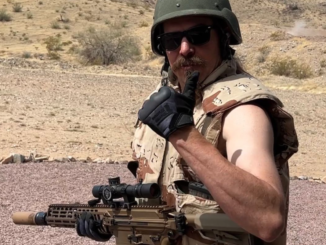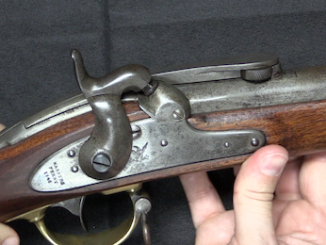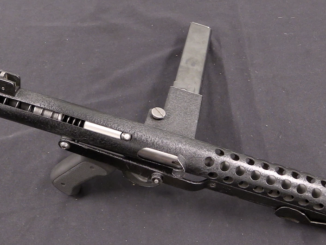In 1880, the South Australian Police service was introduced to the Smith & Wesson No3 New Model revolver at the Melbourne Exhibition. They took a liking to the design, and promptly ordered 250 of them, nickel plated with 7” barrels and detachable shoulder stocks (as well as 30 more with 6.5” barrels and no stocks). These would be issued to mounted officers of the police, for whom they would be a sort of universal weapon – a pistol for close range use, and the stock to allow accurate shooting at longer ranges when called for. An interesting set of holsters was issued with the guns, intended to be carried on the saddle. One is made specifically to carry the shoulder stock, and the other to carry the pistol – but with a pair of flaps such that the gun can be secured in the holster with he shoulder stock still attached.
These revolvers remained in South Australian inventory until 1953, when the were sold as surplus to an American firm, who subsequently sold them to the collector market.




Q: the Broad arrow. Would this have been added later ? It is a marking associated with military weapons, king’s property and all that. A marking one usually does not find on police weaponry.
@john bric, I’m not an expert on this but at the time these were acquired Australia was still a cluster of British colonies and many of the police forces were quite paramilitary in nature. Troopers being the term quite often so a broad arrow would fit.
South Australia had possession of a huge area including what is now the Northern Territory at the time of this purchase which straddled the continent from Northern coast to it’s Southern coast. Wheat growing areas, Murray riverlands and desert coast in the south. Arid and desert in the middle and tropical in the north.
Wow, I was born and raised here in SA and i didn’t know that…
I believe there is a special semi-auto only police version of the H&K MP7 used by the Ministry of Defence Police in the UK which was apparently chosen for a similar reason. They wanted a weapon which could replace both a pistol and a carbine with one firearm.
MP7SF (single fire).
There is/was also a semi-only MP5SF which was mostly sold to U.K. police. It is not a short-barrel HK94 (which was extensively modified for the civilian market to make full-auto conversion hard). It is a regular MP5 that is fitted with a semi-auto only fire control group.
British police thinking was that the officer is legally responsible for each round fired, so needs to make a conscious decision to release each projectile.
Though not a lawyer, I could make a counter-argument that a properly trained individual firing a burst has taken responsibility for all rounds in the burst.
I suspect the reality was a mix of legal liability concerns, PR ones (“machine gun”), training ones (effective hand-held full auto is hard), and tactical pragmatism in a country with low rates of armed crime and very few crims with serious firepower.
I would think that limiting the rate of fire, so to speak, was to hopefully prevent collateral damage (perhaps you got the perp but the two other bullets in a 3-round burst hit the hostage or a bystander). A certain police veteran would tell you why he had more faith in the M1 Carbine than in the HK MP5K, and collateral prevention is one of those: put the bullet where you want it and nowhere else. I could be wrong.
AFAIK during the early aughts FBI was issuing some variant of mp5 (not SD) with a semi and two-round burst but without full-auto capability.
The FBI issued an MP5SF with a full-stock for use by special agents, ’tis true. There was no two-rd. burst nor full-auto. Double-taps were/are not difficult for trained personnel.
Now it’s time for Ian to talk the owner into letting him shoot that old iron on the range. I don’t think I’ve ever seen footage of such a rig being fired. A question: if a modern company created a replica of a 19th. century shoulder stocked handgun such as this, would it be approved for civilian ownership?
In the US, it would be an SBR – $200 tax stamp, relatively easy to get in the Free states.
It’s possible it could get an exemption like several historical stocked pistols. Original Chinese Hi Powers, broom handle Mausers and some other C&R items do not require a tax stamp, but only with a period holster stock
The initial question was about reproductions which would not get an exemption in any circumstances.
Looking at the stock holster, I wonder if it wasn’t intended to hold the stock with the hardware up. That would be easier to grab than the near flush-seated wood, and would explain the rectangular shape.
It’s a little difficult to understand what they were guided by when choosing this for their rangers…
But it’s even harder to imagine a more idiotic choice.
Although no, it is quite possible.
This is the MP7’s choice for police weapons.
Why is this an idiotic choice? I’m assuming you have insight into the conditions in which the 1880s South Australiaian police were operating.
Because with about the same mass as a cavalry carbine, you have a revolver in your hands. Even with a stock, but against a carbine or a shotgun, all the same, no comparison.
And formally, “the policeman already has a carbine, so he doesn’t need a second one.”
Except that with such a butt to knock out the door, or hit on the head. Just for fear of breaking.
Not to mention the fact that the stock, due to its weight (inevitably) will constantly hang on the horse and, according to Murphy’s law, will be out of reach at the right time.
And the revolver itself is ugly heavy. Although for an equestrian, this is not so critical.
This would obviously work well for the postal service, but not for the police.
PS The US Army and Navy have already played with similar pistols-carbines.
The conclusion was unambiguous – “eat this yourself, and give us a normal weapon.”
The Metropolitan Police wasnt formed till 1829 well after the City of Glasgow police and the Belfast Borough police both formed in 1800 and the Edinburgh police in 1805.
Interesting.
It seems to me that one advantage that this kind of rig has over a traditional lever action carbine is that it’s feasible to shoulder and (repeatedly) fire this stocked revolver one handed,which would be valuable if you have to hold a horse’s reins or something while shooting as, say, a mounted policeman might (a bit like the Colt 1873’s right side loading gate)
“one advantage that this kind of rig”(C)
Who prevents you from taking both of them?
The horse will handle it.
https://gunsmagazine.com/handguns/guns-of-the-scarlet-riders/
My grandfather was a Mounted Constable in the South Australian Mounted Police from 1916 until his death in 1948. I have his old Police Manual printed in 1912. The section titled ‘Arms’ refers to these weapons and their use: “The Mounted Police are armed with swords and revolver carbines; the Foot Police with Martini-Henry rifles and staves, the former being only carried as occasion requires. It must never be forgotten by the Police that they are armed with deadly weapons, and in all cases in which death may result from the use of them, would have to justify the necessity of the case to a jury. To justify such necessity, in general, the plea of self-defence is the safest; but this can only be substantiated when acting against armed men, or superior numbers; and it must in all cases appear that no other means would have been sufficient to effect the apprehension of the party.”
Later in the manual it refers to ‘Drill’ stating: “Mounted Counstables (to be instructed) in mounting, position and riding-school drill, sword exercise, troop drill and the use of the revolver-carbine.” Note the different spelling in the two references to the weapons.
In relation to the ‘broad arrow’ marking referred to earlier in this thread, this was commonly used to denote government property throughout the British Empire, not just firearms. For example the Manual refers to Police Horses stating: “Every horse belonging to the establishment to be branded with a broad arrow…”
The SA Police were at that time organised into three groups, Town Police, Detectives and Mounted Police. The functions of the latter were similar to role of the French Gendarmerie – primarily located and acting as police in rural areas, while also being a para-military force in major towns located in central barracks and not taking part in day to day ‘town policing’.
Thank you JSC. I remember in 1950s English comics convicts clothing were covered in Broad Arrows denoting Crown Property rather than the black & white stripes favored by American cartoonists.
“(…) was commonly used to denote government property throughout the British Empire, not just firearms.”
According to https://www.tandfonline.com/doi/abs/10.1179/003962611X13117748891958?journalCode=ysre20
it is very old symbol, used at least since 1330 for denoting that this is property of King and in second half of 19th century was used by surveyors.
Thanks, JSC – great primary document!
Having two nearly indistinguishable but different pistols (6.5 and 7 inches of barrel) seems like a very odd choice. One would think that either they would go for full interchangeability or for significantly shorter pistol for Foot Police
I moved to South Aus in Jan 1959 and the police were unarmed at that stage, they didn’t carry revolvers until about the late 1970’s I think, (still S&W). Now they have Glocks.
The anti gun lobby had a huge headline in 1998, after the Port Arthur killings which led to huge firearms reform in Australia. They told everyone hundreds of pistols had come through customs to flood the firearms market with illegal weapons! Shock, horror, what they failed to mention the Glocks were for the police!
For a mounted officer, that would be hard to beat at the time. John Wayne could cycle a levergun while riding, not many others had his prop budget (trapper length with a custom loop) or friendly editing. One hand operation for the first six shots would be comparatively easy with the revolver.
Whatever the revisionist opinions, it must be recognized that the Australians would not have been more than ordinarily dim and they both bought 250 after trialing one and kept them in service for an awfully long time – so they can’t have been too bad and likely eminently serviceable.
“…kept them in service for an awfully long time – so they can’t have been too bad…”(C)
Judging by the condition of the presented sample, this is not surprising.
It looks like they were purchased without ammunition.